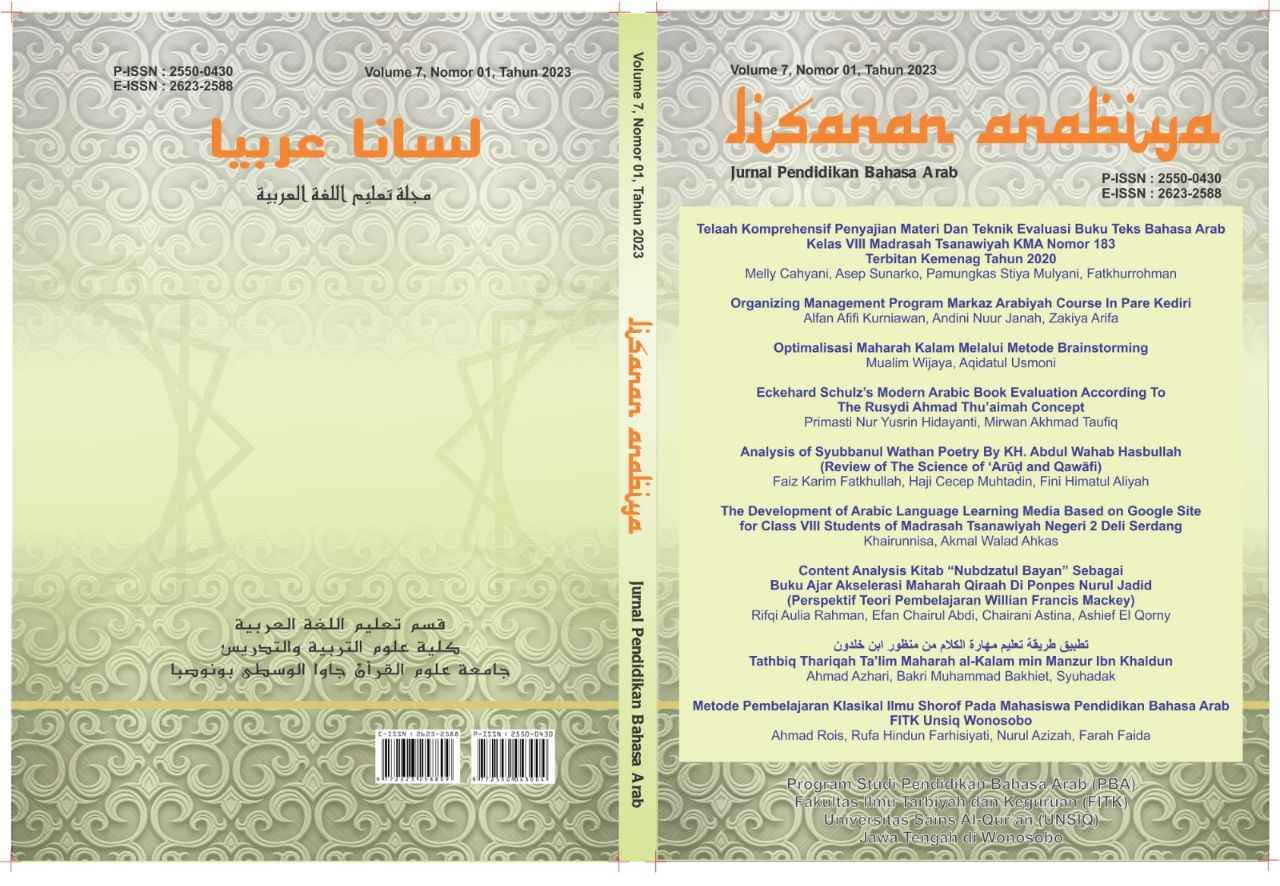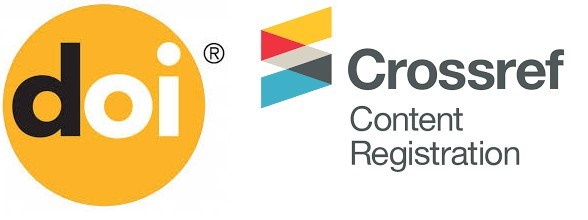Content Analysis Kitab “Nubdzatul Bayan” Sebagai Buku Ajar Akselerasi Maharah Qiraah Di Ponpes Nurul Jadid
Perspektif Teori Pembelajaran Willian Francis Mackey
DOI:
https://doi.org/10.32699/liar.v7i1.4605Keywords:
Content Analysis, Nubdzatul Bayan, Learning Material, Qiraah Skill, Acceleration ProgramAbstract
The research departs from the existence of the accelerated book 'Nubdzatul Bayan' which is used as an acceleration book for Qiraah proficiency at the Nurul Jadid Situbondo Islamic boarding school. This book with 6 volumes of Qawaid Arabic science content has made several Islamic boarding school students able to read Arabic texts in a short time. This research will focus on dissecting the contents of the six volumes of this book with the analysis knife of Willian Francis Mackey's learning theory with four principles, namely Selection, Gradation, Presentation, and Presentation. The research method that the writer uses is literature studies with the primary data being the book. Secondary data was obtained from several research journals and books. The conclusion from the content analysis of this textbook provides information about the purpose of the textbook, as well as the use of this Nubdzatul Bayan book in accordance with its learning outcomes, namely as a Qiraah proficiency acceleration book. The material presented helps determine the relevance of the textbook with the desired learning objectives. This study also provides information about the quality of the presentation of material that is systematic, clear, and easily understood by students. In conclusion, the content analysis of this textbook provides useful information for evaluating the effectiveness and efficiency of textbooks as learning aids. Thus, the analysis of the contents of textbooks becomes important in selecting and using the appropriate textbooks in accordance with the goals and needs of the students' Qiraah proficiency acceleration
References
Al Ahqaf, M. I. (2021). Analisis Kelayakan Bahan Ajar Bahasa Arab Untuk Madrasah Tsanawiyah. Jurnal Al-Maqayis, 6(2), 1–12.
Al-Naqah, M. K. (1985). Ta’lim al-Lughah al-Arabiyyah Li al-Nathiqin Bi Lughat Ukhra: Ususuh, Mahakhiluh, Thuruq Tadrisih. Makkah Al-Mukarramah: Jami’at Um al-Qura.
Dewi, S. N., Halawa, M. H., & Nifanngelyau, L. (2021). Dampak covid-19 terhadap bisnis property. Jurnal Pendidikan Ekonomi (JPE), 1(1), 20–25.
Effendy, A. F. (2005). Metodologi pengajaran bahasa arab. Malang: Misykat, 35.
Hadi, N. (2018). Analisis Isi Buku Ajar Bahasa Arab (Pendekatan Saintifik Kurikulum 2013) Kelas I Madrasah Ibtidaiyah Terbitan Kementerian Agama Republik Indonesia 2014. Ijaz Arabi Journal of Arabic Learning, 1(1).
Hamid, M. A. (2008). Pembelajaran bahasa Arab: Pendekatan, metode, strategi, materi, dan media. UIN-Maliki Press.
Hermanto, B., & Rudi, A. (2022). ESENSI KAIDAH TIKRARIYAH DALAM MEMAHAMI BAHASA ARAB. Kariman: Jurnal Pendidikan Dan Keislaman, 10(1), 61–76.
Kusumo, G. (2017). Pengembangan bahan ajar terintegrasi dengan pendidikan karakter pada mata pelajaran bahasa Indonesia SD kelas IV. Transformatika: Jurnal Bahasa, Sastra, Dan Pengajarannya, 1(1), 1–18.
Mackey, W. F. (1967). Language Teaching Analysis.
Mawardati, K. (2021). Analisis Buku Ajar Bahasa Arab Durusul Lughoh Al Arabiyyah karya Imam Zarkasy dan Imam Syubani Jilid I. El-Hayah, 11(1).
Nasrulloh, M. A., & Mufidah, I. (2022). Analisis Konten Buku Ajar Bahasa Arab Sang Pangeran Nahwu Al-Ajurumiyyah. TADRIS AL-ARABIYAT: Jurnal Kajian Ilmu Pendidikan Bahasa Arab, 2(1), 17–35.
Nirmayani, L. H. (2022). Kegunaan Aplikasi Liveworksheet Sebagai LKPD Interaktif Bagi Guru-Guru SD di Masa Pembelajaran Daring Pandemi Covid 19. Edukasi: Jurnal Pendidikan Dasar, 3(1), 9–16.
Pahlevi, R. (2020). Analisis Buku Al-‘Arabiyyah Baina Yadaik Jilid I: Tinjauan Komponen dan Tahap Penyajian Materi Buku Teks Bahasa Arab. Al-Ittijah: Jurnal Keilmuan Dan Kependidikan Bahasa Arab, 12(2), 157–176.
Rahman, R. A. (2018). KEMAHIRAN QIRĀ’AH DAN KONSIDERASI STRATEGI PEMBELAJARAN. Lisanan Arabiya: Jurnal Pendidikan Bahasa Arab, 2(1), 97–120.
Rahman, R. A. (2021). MENYOROTI METODE PENYELIDIKAN SAINS DAN AGAMA ROLSTON HOLMES III. Manarul Qur’an: Jurnal Ilmiah Studi Islam, 21(2), 149–164.
Rois, A., & Rahman, R. A. (2020). HUMANISM-BASED ARABIC LANGUAGE TEACHING DEVELOPMENT TO IMPROVE LIVING VALUE OF UNSIQ WONOSOBO STUDENTS. International Review of Humanities Studies, 5(1).
Rosyad, M. S. (2018). ANALISIS BUKU AJAR BAHASA ARAB SISWA KELAS VIII MTs/SMP ISLAM DALAM PERSEPEKTIF GENDER. JALIE; Journal of Applied Linguistics and Islamic Education, 2(2), 381–395.
Rosyadi, S. (2021). Analisis Buku Ajar Bahasa Arab Madrasah Ibtidaiayah Kelas 1 Dari Kementrian Agama Republik Indonesia. Jurnal Al-Maqayis, 6(1), 1–14.
Rosyidin, D. (2002). Metodik Khusus Pengajaran Bahasa Arab. Jakarta.
Sadiman, A. (2002). Media pembelajaran dan proses belajar mengajar, pengertian pengembangan dan pemanfaatannya. Jakarta: Raja Grafindo Persada.
Sahrani, S., & Rahnang, R. (2019). Pembelajaran Muhadatsah melalui Metode Drama pada Program Praktikum Jurusan Pba Iain Pontianak. Ihya Al-Arabiyah: Jurnal Pendidikan Bahasa Dan Sastra Arab, 5(1), 10–32.
Syaḥātah, Ḥasan. (1992). Talīm al-Lughah al-Arabiyah Baina an-Naẓariyah Wa aṭ-Ṭaṭbīq. Dār Al-Miṣriyah al-Lubnāniyah, Dūn as-Sanah.
Tarigan, H. G., & Tarigan, D. (1986). Telaah buku tekst bahasa Indonesia. Angkasa.
Zaenuri, M. (2019). Analisis Buku Ajar Belajar Membaca Kitab Kuning Metode Ibtida’i Karya Mujahidin Rohman. Arabia: Jurnal Pendidikan Bahasa Arab, 11(1), 191–212
Downloads
Published
Issue
Section
License
Authors who publish with this journal agree to the following terms:
a. Authors retain copyright and grant the journal right of first publication with the work simultaneously licensed under a Creative Commons Attribution-ShareAlike 4.0 International License. that allows others to share the work with an acknowledgement of the work's authorship and initial publication in this journal.
b. Authors are able to enter into separate, additional contractual arrangements for the non-exclusive distribution of the journal's published version of the work (e.g., post it to an institutional repository or publish it in a book), with an acknowledgement of its initial publication in this journal.
c. Authors are permitted and encouraged to post their work online (e.g., in institutional repositories or on their website) prior to and during the submission process, as it can lead to productive exchanges, as well as earlier and greater citation of published work (See The Effect of Open Access).












